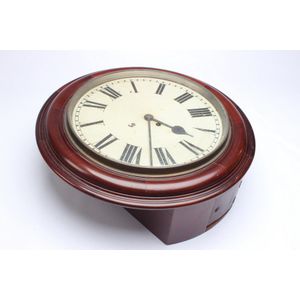Mahogany Railway Clock with Pendulum and Roman Dial
mahogany railway clock with pendulum in the classic timber frame and Roman numeral dial, two doors to back housing reveal a brass W.F.E King and Sons Birmingham movement with key and pendulum, diameter 50 cm
You must be a subscriber, and be logged in to view price and dealer details.
Subscribe Now to view actual auction price for this item
When you subscribe, you have the option of setting the currency in which to display prices to $Au, $US, $NZ or Stg.
This item has been sold, and the description, image and price are for reference purposes only.
- Pendulum - The pendulum was discovered around 1602 by Galileo Galilei, and was adopted for time keeping by the Dutch mathematician and natural philosopher, Christiaan Huygens, who excelled in astronomy, physics, and horology.
The pendulum comprises a metal rod usually of brass or steel with a metal disk, known as a bob, at the end. The movement of the pendulum is driven by weights or a spring, and as a pendulum swings in a regular arc, it was found accuracy could be controlled to within a few seconds a week.
Timekeeping can be adjusted by changing the height of the bob on the rod, making the pendulum either swing slower or faster.
The disadvantage of the pendulum was that changes in temperature also changed the length of the pendulum, interfering with the accuracy of the clock, and so in the 18th century two types of mercurial pendulums were invented which countered the movement in the steel rod.
The pendulum was the world's most accurate timekeeping technology until the invention of the quartz clock, regulated by a quartz crystal, in 1927. - Mahogany - Mahogany is a dense, close grained red-coloured timber from the West Indies and Central America. It was first imported into Europe in the the early 18th century and its use continued through the 19th century. It was popular for furniture making because of its strength, the wide boards available, the distinctive grain on some boards, termed flame mahogany and the rich warm colour of the timber when it was polished.. The "flame" was produced where a limb grew out from the trunk of the tree, and this timber was usually sliced into veneers for feature panels on doors, backs and cornices.
Some terms used to describe mahogany relate to the country from which it originally came, such as "Cuban" mahogany, "Honduras" mahogany etc. However unless the wood has been tested the names assigned are more a selling feature, rather than a true indication of the timber's origin. - Movement - The technical name for the workings of a clock or watch, and does not include the dial or case.
This item has been included into following indexes:
Visually similar items

Wall clock. Antique English circular oak case with fusee movement. Diameter 30 cm
Sold by
in
for
You can display prices in $Au, $US, $NZ or Stg.

A mahogany framed circular wall clock by Elliot, with New Zealand Government stamp, cream enamel dial with Roman numerals. Diameter 27.5 cm
Sold by
in
for
You can display prices in $Au, $US, $NZ or Stg.

Antique Black Forest wall clock, pendulum and weights available. Untested.
Sold by
in
for
You can display prices in $Au, $US, $NZ or Stg.

Antique Thwaites and Reed, London fusee mahogany wall clock, approx 37 cm diameter
Sold by
in
for
You can display prices in $Au, $US, $NZ or Stg.
